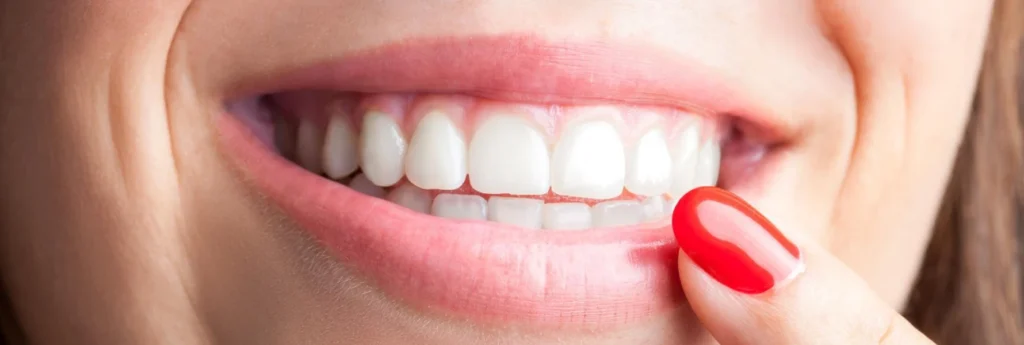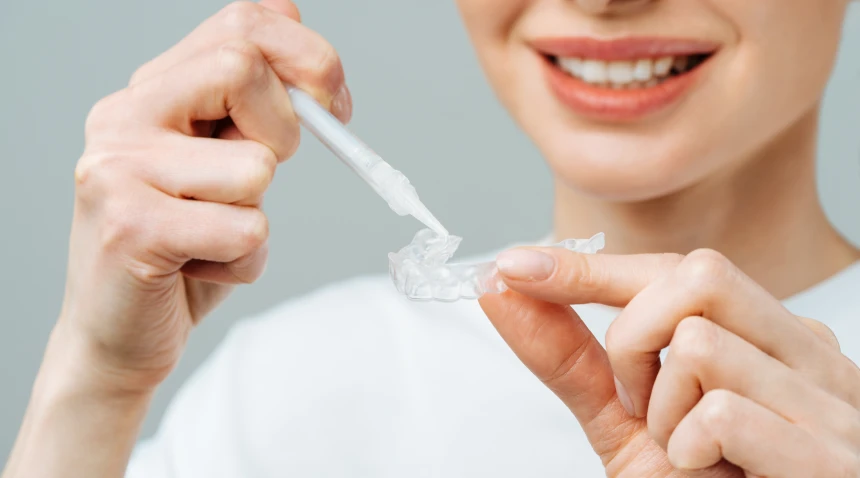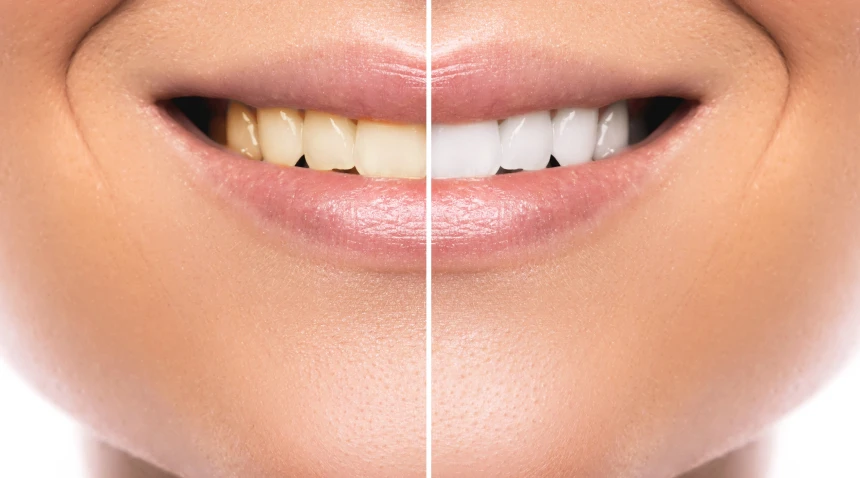Teeth whitening, also known as dental bleaching, aims to improve the shade of the teeth by acting on discoloration both on the surface and within the enamel itself. Unlike a simple scaling, it goes beyond removing tartar or superficial stains. This treatment uses active agents such as hydrogen peroxide or carbamide peroxide to lighten the internal pigments.

Програма ChatGPT сказала:
The causes of tooth discoloration are varied. Some come from external factors such as coffee, tea, tobacco, or certain spices. Others originate from internal causes, including aging, specific medications, or dental trauma. In all cases, whitening can bring a noticeable improvement when performed under professional supervision.
At-home teeth whitening under professional supervision
At-home teeth whitening follows a well-defined and supervised protocol. After a clinical examination at the dental office, the dentist ensures that the teeth and gums are healthy. This initial evaluation helps prevent potential complications, such as pain or increased sensitivity.
Once oral health is confirmed, the dentist takes impressions to create custom-made trays. These trays, tailored to the patient’s morphology, allow for precise and even application of the whitening gel.

At-home use is carried out according to the dentist’s instructions. In most cases, patients wear the trays for a few hours per day or overnight, over a period of one to two weeks. Throughout the treatment, the dentist can adjust the duration or concentration of the product based on the patient’s feedback, ensuring personalized supervision.
This approach provides a natural, aesthetic result tailored to each patient’s smile.
A gentle, gradual, and controlled approach
This method offers several advantages. First, it works progressively. Thanks to the low concentration of gel, the teeth whiten gradually, which helps minimize the risk of sensitivity. In addition, the patient maintains control over the duration and frequency of each application.
This flexibility allows the treatment to be adjusted over time based on the patient’s reactions. If any discomfort occurs, the trays can be paused temporarily and resumed once comfort is restored. This adaptability enhances both safety and enamel protection.
Moreover, custom-made trays prevent the whitening gel from overflowing onto the gums, which could otherwise cause irritation. With this personalized adjustment, the treatment remains precise, safe, and effective.
Who can benefit from teeth whitening?
Many people consider teeth whitening to enhance the brightness of their smile. However, this treatment is not suitable for everyone and must be carefully assessed.
It can be beneficial in several cases:
- Gradual yellowing of the teeth due to aging
- Stains caused by coffee, tobacco, red wine, or spices
- Aesthetic preparation before fitting crowns or veneers
- Personal desire to improve the appearance of the smile

It’s important to note that whitening does not change the color of existing restorations, such as fillings or crowns. These may need to be replaced afterward to achieve a uniform result.
The dentist always explains the possibilities, limitations, and realistic expectations before beginning treatment.
What to know before starting
Before whitening, a healthy mouth is essential. The dentist performs a full check-up and treats any cavities, gingivitis, or excessive sensitivity beforehand.
A professional cleaning is also recommended before starting the procedure, as it allows the whitening gel to act evenly on all tooth surfaces.
Additionally, this treatment is not suitable for pregnant or breastfeeding women. The final shade depends on each tooth’s natural response — while an exact color cannot be guaranteed, the practitioner guides the patient toward a natural, harmonious result.
Possible side effects and management
Although professionally supervised, some patients may experience temporary tooth sensitivity, particularly to cold. This reaction is mild and usually subsides within a few days or after pausing treatment.
In such cases, the dentist may recommend a toothpaste for sensitive teeth, shorten the tray-wearing time, or space out the applications. These measures ensure comfort while maintaining the treatment’s effectiveness.
Mild gum irritation can sometimes occur due to gel overflow — another reason why custom-made trays are essential to minimize this risk.
Practical advice during treatment
To optimize results, certain habits are recommended throughout the whitening process:
- Brush your teeth after each meal
- Avoid staining foods and drinks (curries, red fruits, dark beverages)
- Refrain from smoking
- Limit acidic or carbonated drinks
- Follow the dentist’s instructions precisely

These measures are especially important during treatment since teeth may be more porous and susceptible to staining.
How long do results last?
Whitening results are long-lasting but not permanent. Over time, slight discoloration may return depending on lifestyle and dietary habits. The average stability period ranges from one to three years.
Maintenance sessions can be done as needed. Since the trays are reusable, a new prescription for the gel allows touch-ups under professional supervision.
With good oral hygiene and limited exposure to staining substances, patients can maintain a bright, radiant smile for a long time.
FAQ – Teeth Whitening
- Does whitening hurt?
No, the treatment is usually painless. Some temporary sensitivity to cold may appear, but it typically resolves on its own. - Can a single dark tooth be treated?
Yes. A darker or devitalized tooth can be treated with a specific protocol. The dentist will assess and tailor the solution accordingly. - Is the result immediate?
No. The process is gradual — noticeable changes appear after a few days, with full results visible within two to three weeks. - Can the trays be reused?
Yes, as long as there have been no dental changes (such as prosthetics or tooth movement). They can be reused for maintenance sessions with dentist-prescribed gel. - Are there any contraindications?
Whitening should be avoided or postponed in certain cases: pregnancy, breastfeeding, active cavities, gum disease, or severe enamel wear.
To learn more or book an appointment
Considering teeth whitening but unsure if it’s right for you? A preliminary consultation will provide personalized answers and determine if the treatment suits your needs. Located in Paris 16, Cabinet dentaire Mirabeau welcomes you in a calm, professional setting. Book your appointment online to start your smile-enhancement journey with confidence.
You may also like: Dental veneers